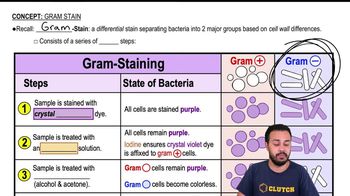Here are the essential concepts you must grasp in order to answer the question correctly.
Acid-Fast Staining
Acid-fast staining is a differential staining technique used primarily to identify mycobacteria, such as Mycobacterium tuberculosis. This method exploits the unique lipid-rich cell wall of acid-fast bacteria, which retains the primary stain (carbol fuchsin) even after being washed with acid-alcohol. Understanding this process is crucial for recognizing the significance of counterstains in visualizing non-acid-fast organisms.
Recommended video:
Simple Staining Basic & Acidic Dyes
Counterstain
A counterstain is a secondary stain applied after the primary stain in a staining procedure. In the context of acid-fast staining, a counterstain (commonly methylene blue) is used to color non-acid-fast bacteria, allowing for differentiation between acid-fast and non-acid-fast organisms under a microscope. This step is essential for providing contrast and enhancing the visibility of the sample.
Recommended video:
Differential Staining
Differential staining is a technique that uses multiple stains to distinguish between different types of cells or cellular components. It is fundamental in microbiology for identifying and classifying bacteria based on their structural differences. The acid-fast stain is a prime example of differential staining, as it highlights the unique properties of certain bacteria, aiding in diagnosis and treatment decisions.
Recommended video:
 Verified step by step guidance
Verified step by step guidance Verified video answer for a similar problem:
Verified video answer for a similar problem:

